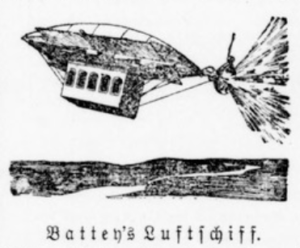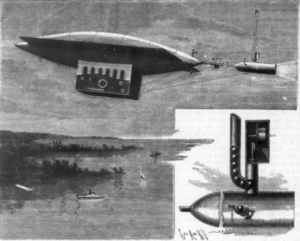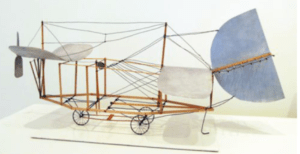Following on from my last post on metal-clad airships, I thought I ought to look a little more closely at Dr Sumter Beauregard Battey of New York and his nitro-glycerine-pellet-powered airship design.
Dr Sumter Beauregard Battey
As is so often the case, his obituary in the New York Times (included on his findagrave.com page) is a good place to start (2 Feb 1934):
Sumter B. Battey, physician and surgeon, died yesterday at his home, 700 West 179th Street, after a brief illness of heart disease with complications.
Surviving are his second wife, Mrs. Edith Carter Battey, and a son of the first marriage, Bryan Mann Battey, of the law firm Fraser, Myers & Manley, New York City. His first wife, who died in 1917, was Dr. Sarah A. French at their marriage in 1895.
Dr Battey, son of William Henry and Frances Whatley Battey, was born seventy-two years ago on one of the family plantations at Louisville, Ga. Hew was graduated from the University of Georgia Medical College in 1885. After a period of post-graduate work he settled in New York City.
Apart from professional activities, Dr Battey was known for his attainments in the field of invention. He made several important technical contributions in the mechanical arts.
Among the ancestors of Dr. Sumter Battery were Caleb Carr, first Colonial Governor of Rhode Island, and General Stephen Heard, Governor of Georgia during the Revolution. William Henry Battey, father of Dr. Battey, was killed in the Battle of Antietam while leading his men, known as the “Battey Guards”.
Inventions
As well as the electric bicycle and airship mentioned in the previous post, Battey also invented a lighter, a liquid self-igniting device, a razor stropping device, a railway track switching mechanism, a hair waving or curling device, a “repeating mechanism for talking machines”, and a number of sewing machine-related patents. He also had a sewing machine company in East Orange, NJ, as reported in the Sewing Machine Times of 25 June 1905 (though this was voided in 1910 “for nonpayment of taxes”):
In New Jersey: The Battey Self-threading Sewing Machine Company, of 30 Halsted street, East Orange, formed to make and sell all kinds of machines and to deal in patents and inventions, and to operate plans of all kinds. The authorized capital stock is $120,000, of which $1,000 has been paid in. The incorporators are S. B. Battey and W[ade] Hampton de Fontaine, of New York, and Alfred Miller of Chicago.
I also found an article in an American German-language newspaper (Der Deutsche beobachter, 21 Oct 1896) which included images of both Battey’s Luftschiff and C. A. Smith’s Luftschiff:
The invention preceding Battey’s airship seems to have been for “The Lighting of High Gas Jets”, as reported on the 14 Dec 1889 issue of the Australian Town and Country Journal (Sydney NSW):
A new device for conveniently lighting gas jets placed above ordinary reach, as in halls, has been invented by S. Battey, of New York City. The method of lighting is by means of little percussion caps. Those pellets are held in a tube, and are fed, one at a time as required, to a cylinder which has an opening opposite the tip of the burner. After the gas has been turned on, the caps are forced up and ignited in front of the jet by a piston which is set in motion through the medium of a spring which is operated upon at the time the gas key is turned by the person using the apparatus.
Battey’s Airship in Scientific American
An article in bleedingcool.com mentions Sumter Battey in passing, because the writer is taken by the idea that the the flying machine behind the 1897 airship flap was in fact built by Moses S. Cole. However, I thought the whole paragraph was noteworthy, because it gives an insight into Battey’s patent agents:
It’s no random happenstance that an artist’s depiction of Cole’s patent in action was featured on the cover of Scientific American. as he filed his patent via that periodical’s publisher. Scientific American‘s publisher, Munn & Co., was also a patent agent, and patents filed through Munn & Co. were often featured in the magazine. In addition to Cole’s cover feature in 1887, other airship patents that the company helped file and then publicized in Scientific American during this era include Sumter Beauregard Battey’s Aerial Machine in 1892 and Herman A. J. Rieckert’s “improved airship” in 1889.
The Scientific American article on “Battey’s Aerial Ship” included a rather natty-looking depiction:
I think it’s worth including the text in full:
The principal feature of the means of aerial navigation shown in the picture consists in the method of propulsion employed, the power for this purpose being affords by discharges of small and readily regulated quantities of a high explosive, of which a very considerable amount can be carried without adding greatly to the weight of the whole apparatus. The balloon portion of this air ship is of a cigar-shaped module, having a framework of aluminum, covered with oiled silk of other suitable fabric, or with a thin envelope of aluminum, and is of sufficient size to afford, when filled with a light gas, a lifting power corresponding with the weight of the car and the load it is proposed to carry, all of the apparatus and fittings being of the lightest possible construction consistent with the necessary strength. At each side of the body are wings or side planes, to guide the ship up or down, according to the inclination given them, these vanes turning on a horizontal axis, consisting of an aluminum tube extending through the center of the body. As seen in the broken-away portion of the car shown in the main view, wire ropes or cables from these side vanes extend over pulleys with gear wheel connections within the car, so that the operator, by the movement of a lever, can regulate to a nicety the inclination of the vanes.
The propelling apparatus, in which the main novelty of this invention lies, is supported upon a hinged arm at the rear. It consists, practically, of a horizontally arranged mortar-like tube, forming the end of the arm, and above this tube, as shown in more detail in the small view, is a tubular magazine containing globular or pellet-like charges of a high explosive, with the mechanism for regulating their supply to the discharge tube. The explosions, as they take place in this tube, exert a powerful backward pressure upon the air, which may be more or less continuous, according to the power to be applied to propulsion and the rate of speed sought to be attained, an air cushion back of the explosive chamber protecting the machine from shock. The rate of discharge may be controlled through a wire extending to within easy reach of the operator within the car, while light wire cables extend from the discharge tube over pulleys to a gear wheel steering apparatus in the car, the arrangement being such that the tube may be readily swung to one side or to the other as desired, the direction of the ship in the air being thus conveniently controlled. The discharge tube thus at the same time supplies the motive force and constitutes the rudder. The charges are fed automatically to the point discharge, the pellets dropping into a shallow cup or basin, which is made by the contact to complete an electric circuit, whereby the firing is effected, each pellet completing the circuit for its own explosion and at once breaking the circuit.
It is the belief of the inventor that with one of these machines, possessing a minimum of weight, owing to the absence of machinery and the use of aluminum instead of iron or steel for the framework and all the working parts, and provided with the maximum of power, due to the nature of the force employed, a speed can be attained excelling even that of bird flight. The car may be gradually reduced in fore width and aft to a sharp vertical edge at each end, offering the least possible resistance to motion, and it is suspended by aluminum wires and cords from the entire length of the body. It is designed also that machines of this type may be used for carrying freight and for regular passenger service, and their value will be obvious for such purposes as military observations, carrying of mails and dispatches, etc. This new air ship has been presented in the United States and the principal European countries by Dr S. B. Battey, of No. 39 West Twenty-seventh Street, New York City.
Though Battey’s airship was arguably the first genuine attempt at making a rocket-powered aircraft, by 1918 the Bridgeport Times and Evening Farmer was poking fun at it for using nitroglycerine for its motive power (though laughing even harder at Edwin Pynchon of Chicago, who powered his airship with dynamite).
Legacy of Sumter Battey
Artist Adrian Nivola produced a series of pieces celebrating flight pioneers, one of which was “Homage to Sumter Battey, 2014, wire, wood, tin, found objects 14 x 30 x 10 1/2 inches (AN6998)”:
“Robur the Conqueror”
Finally, I should briefly mention Jules Verne’s 1886 novel “Robur the Conqueror” (which was broadly adapted into a 1961 film with Vincent Price). There, the main protagonist is a megalomaniac inventor called Robur who builds a heavier-than-air battery-powered aircraft on his secret X island, takes over the meeting of the Weldon Institute (a fictional Lighter-Than-Air society in Philadelphia) and kidnaps its president to try to show them the error of their balloon-based ways, with hilarious consequences.
What Verne was tapping into (some 40 years before the Wright Brothers) was the broadly-held cultural anticipation of powered flight, along with a whole bunch of mad scientist tropes. Ultimately, what Robur conquered was the air: Sumter Battey was merely one of a whole generation of ingenious mechanics who saw no reason to wait for a Robur to turn up to do the same.




Hmm…just reading this now. I have sort of paid attention to these stories Nick. Im guessing you are angling to try and figure out what happened at Roswell and the possible mysterious glyphs on the crashed device, whatever it was.
On this one, the mysterious “X” island caught my eye from . Is this even possible? Some sort of phantom island where you could offshore stuff away from prying eyes? The concept has been in science fiction for a lonnng time.